Since the start of the protest movement in Iran almost a month ago, more than 20 children have been killed in the repression and hundreds imprisoned, some being held in centers responsible for “re-educating” them, according to NGOs.
Iran has been rocked since September 16 by protests sparked by the death of Mahsa Amini, a 22-year-old Iranian Kurd who died three days after she was arrested by vice police in Tehran for allegedly breaking the code. Islamic Republic’s strict dress code for women, including the wearing of the veil.
“Woman, life, freedom” or “Death to the dictator” chant the Iranian women, spearheading the demonstrations in which many young people also participate, sometimes at the risk of their lives.
Amnesty Iran mentions on Twitter at least 23 children “illegally killed by Iranian security forces”. “The victims are between 11 and 17 years old”, specifies the organization.
According to the US-based NGO Human Rights Activists News Agency (HRANA), at least 26 youths have been killed since mid-September and three of them were 12 years old.
But the toll could be even higher, say NGOs.
On the other hand, the Iranian Society for the Protection of Children’s Rights, based in Iran, reported this week that families were “kept in the dark” about the fate of their arrested children who are otherwise deprived of legal representation.
Some young people are imprisoned in centers for adult drug offenders, warned Hassan Raissi, an Iranian human rights lawyer.
This information “is very worrying”, he judged, believing that young people “under the age of 18 should never be detained with criminals over the age of 18. It is a legal obligation”.
According to this lawyer, quoted on Wednesday by the news site IranWire“around 300 people aged between 12-13 and 18-19 are in police custody”.
“Antisocial”
UNICEF said on Monday it was “very concerned” about reports of “children and adolescents killed, injured and arrested”.
Iranian Education Minister Youssef Nouri admitted that school children had been arrested on the streets or in their schools.
” There are not a lot. I cannot give an exact number,” he said, according to statements published by the reformist newspaper on Wednesday. Shargh.
He specified that these young people were detained in “medico-psychological centers” where they are subject to “re-education” so that they do not become “antisocial”.
The Iranian teachers’ union criticized the minister and “strongly condemned these ill-advised actions which will lead to the re-education centers becoming military camps”.
In a written statement, the teachers called on “all concerned” to “promptly release imprisoned students” and teachers arrested for their support of the movement.
Despite severe internet access restrictions imposed by authorities to deal with what they call “riots”, young Iranians have managed to post images of the protests on ultra-popular apps like TikTok and Instagram.
Ali Fadavi, deputy commander of the Revolutionary Guards, the regime’s ideological army, told the local press in early October that “the average age of those arrested in many of the recent demonstrations was 15”.
“Some teenagers and young adults arrested have […] compared the riots to video games” in their “confession”, he said, quoted by the news agency More.
The cleric Aboulfazl Ahmadi, head of a provincial organization linked to the morality police, recently considered that the “enemies” of Iran – a term which according to the authorities designates forces abroad such as the United States – had “bet on” teenagers and that video games had been created to “attract young people to the streets”.
